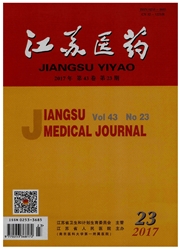

 中文摘要:
中文摘要:
目的测定创伤性脑损伤患者血清泛素羧基末端水解酶L1(UCH—L1)和神经元特异性烯醇化酶(NSE)的含量,探讨其临床意义。方法选择创伤性脑损伤患者55例,按格拉斯哥昏迷评分(GCS)分轻中度组(9—15分,25例)和重度组(3—8分,30例);选择30例正常体检者作为对照组。采集伤后12h静脉血,以ELISA法测定三组血清UCH—L1及NSE的含量,分析其与损伤程度及预后的关系。结果与对照组相比,轻中度、重度组患者伤后12h血清UCH—L1及NSE浓度升高(P〈0.05);且重度组高于轻中度组(P〈0.05)。血清UCH-L1及NSE水平与创伤性脑损伤患者的预后呈负相关(r=-0.657,r=-0.728,P〈0.01)。结论创伤性脑损伤患者血清UCH-L1和NSE检测有助于判断损伤程度和预后。
 英文摘要:
英文摘要:
Objective To detect serum levels of ubiquitin carboxy-terminal hydrolase L1 (UCH-L1) and neuron specific enolase(NSE) and explore their clinical significance in the patients with traumatic brain injury(TBI). Methods With ELISA, serum levels of UCH-L1 and NSE were detected in TBI patients with Glasgow Coma Scale(GCS) of 9-15(group A, 25 cases), TBI patients with GCS score of 5-8(group B, 30 cases) at 12 h after TBI, and healthy persons(group C, 30 cases). The correlation between serum levels of UCH-L1 and NSE with the prognosis of TBI cases was analyzed. Results Compared with group C,serum levels of UCH-L1 and NSE were higher in groups of A and B than those in group C(P〈0. 05),which were higher in group B than those in group A (P〈0. 05). Serum levels of UCH-L1 and NSE were negatively correlated with the prognosis of TBI patients(r=-0. 657, r=-0. 728,P〈0. 01). Conclusion Detection of serum UCH-L1 and NSE is helpful in evaluating the severity of TBI and predicting early prognosis of the patients with TBI.
 同期刊论文项目
同期刊论文项目
 同项目期刊论文
同项目期刊论文
 Contribution of NKX2-3 polymorphisms to inflammatory bowel diseases: a meta-analysis of 35358 subjec
Contribution of NKX2-3 polymorphisms to inflammatory bowel diseases: a meta-analysis of 35358 subjec Neurogenin 2 converts mesenchymal stem cells into a neural precursor fate and improves functional re
Neurogenin 2 converts mesenchymal stem cells into a neural precursor fate and improves functional re 期刊信息
期刊信息
